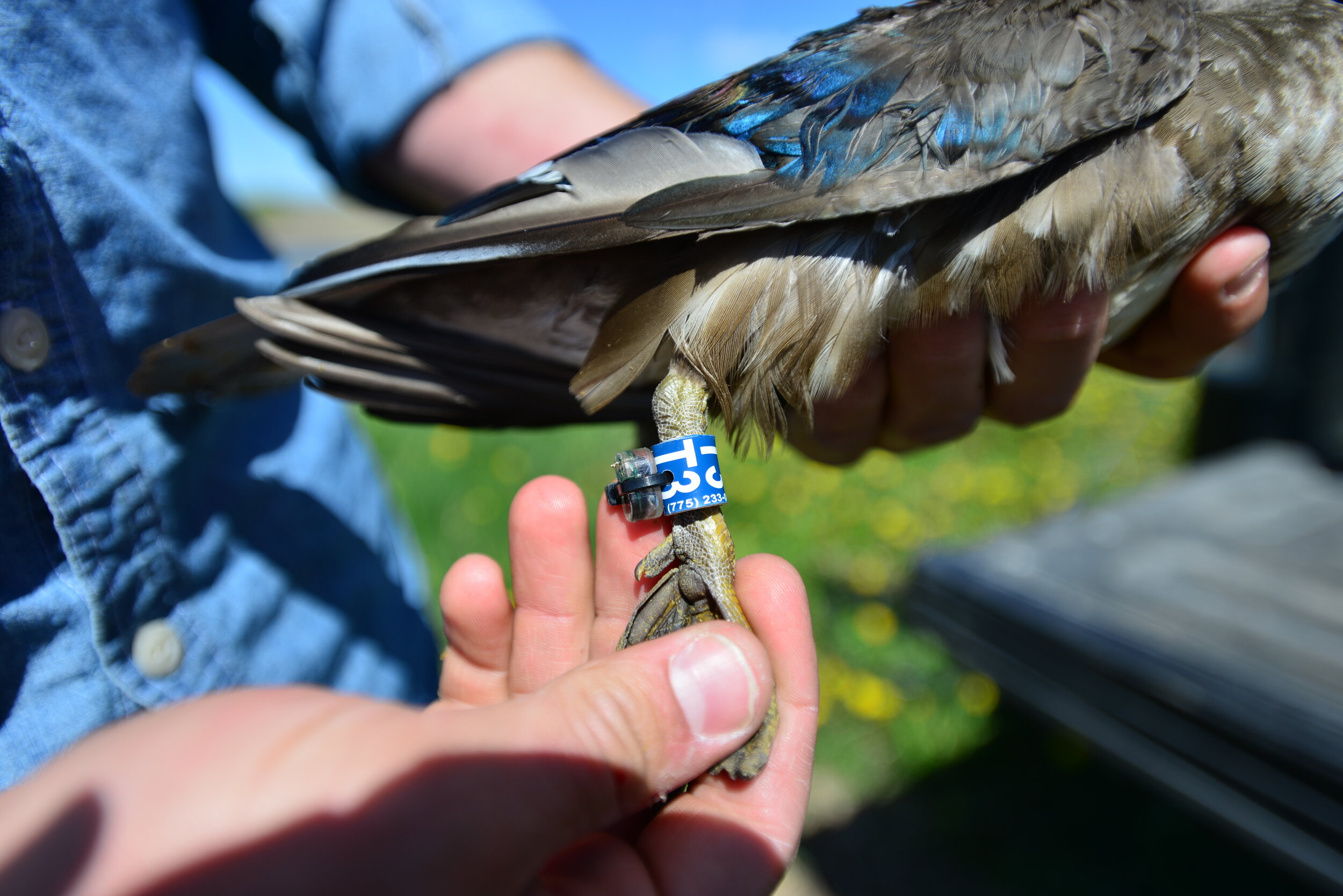Wood duck box, photo by Richard Armstrong
Wood Ducks are an interesting species since they nest in cavities in trees and duck boxes. Decades ago some people thought that Wood Ducks may go extinct due to over hunting and extensive cutting of old growth forest trees.
Art Hawkins, after obtaining a masters degree in wildlife management by studying wildlife under Aldo Leopold at Faville Grove, worked with Frank Belrose and erected Wood Duck boxes made of cypress to try and bring back the birds. Their basic research resulted in people erecting thousands of “Wood Duck boxes” to help increase Wood Duck numbers.
And wonderfully, it worked! Hunting regulations and the regrowth of hardwood forests has also helped increase Wood Duck numbers. Wood Ducks may be the second-most common nesting duck in Wisconsin behind the Mallard.
Wood ducks swimming around Goose Pond, April 9, 2021.
Waterfowl researchers and those who like to hunt and observe Wood Ducks like to learn as much as possible about their ecology and ways to increase their numbers.
Waterfowl researchers are using light-level geolocators to understand the annual migratory pathways of waterfowl and to assess the timing and location of individual breeding activities. Migration Technology Ltd introduction gives an overview how their geolocators work: “Light level geolocation is the method of using measured ambient light level (solar irradiance) to establish geographical location using astronomical algorithms. To record light data, our geolocators contain a battery, small computer, memory and an accurate clock.”
Hen wood duck captured at Goose Pond showing geolocator and colored leg band. Photo by Mark Martin
Ben Sedinger, Kennedy-Grohne Chair in Waterfowl and Wetlands Conservation, at UW-Steven’s Point has a masters student studying Wood Duck nesting ecology at the Mead Wildlife Area northwest of Steven’s Point. Past students learned at Mead that hen Wood Ducks prefer to nest in tree cavities over Wood Duck boxes if large acreage of forest land with large trees is available.
Ben’s students are attaching very small geolocators to a leg band to study nesting success and migrating movement and locate the Wood Duck wintering areas. These geolocators have to be recovered by hunters or researchers who capture the ducks the following year to obtain the data. Luckily, hen Wood Ducks return to nest in the same area the following year. Wood Ducks pair on the wintering grounds. The drake follows the hen to her natal area. They only pair up for one season so a drake hatched at Goose Pond this spring could pair this winter with a female hatched in Arkansas one year and maybe the following year pair with a hen from the Great Lake states.
This year Drew Fowler and Jessica Jaworski, both Research Scientists with the DNR are helping the Steven’s Point Wood Duck masters student by attaching up to one hundred geolocators in southern Wisconsin. The locators each cost $120 and are funded by endowed funds for the Kennedy-Grohne Professor at Steven’s Point.
Drew about to release a banded and geolocator-tagged Wood Duck hen. Photo by Mark Martin
Drew and Jessica have been busy trying to deploy the locators. They have attached over 40 locators at Zeloski Marsh, part of the Lake Mills Wildlife Area. Madison Audubon purchased the 1,461 acre Zeloski farm in 2003 using grant funds, and donated 1,426 acres of it to the DNR. An eagle scout erected 60 nest boxes as the marsh that has resulted in probably around 7,000 Wood Duck and Hooded Merganser ducklings jumping from the boxes!
This week Drew and Jessica attached a geolocator to a hen Wood Duck that is nesting in one of our four nest boxes at Goose Pond. They also finished placing 13 geolocators on nest boxes at our Wildland LLC property near Rio and at the nearby Jurgerson farm.
John Jurgerson, a proud landlord of many wood duck apartments, about to release a hen after banding and tagging. Photo by Mark Martin
They would have placed out four more locators, but the nests hatched a few days ago. We were checking boxes with our camera and found a Wood Duck nest with newly hatched ducklings on Mother’s Day—one happy mother. We found hens incubating nests with between 8 and 24 eggs. We also found 29 Wood Duck eggs in a dump nest that was not being incubated and a few nests with a couple of Hooded Merganser eggs.
We are looking forward to checking the nest boxes next year and finding Wood Duck hens that returned with their geolocators to learn more about their migrating and wintering area and also look forward to writing another feature with the results.
Written by Mark Martin and Susan Foote-Martin, Goose Pond Sanctuary resident co-managers
Cover photo by Arlene Koziol









